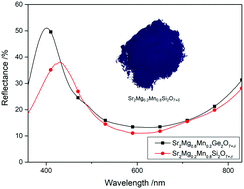Synthesis of non-toxic inorganic blue pigments in the melilite-type structure†
Abstract
A series of novel melilite-type structured compounds of the general formula Sr2Mg1−xMnxGe2−ySiyO7+δ (0 ≤ x ≤ 1; 0 ≤ y ≤ 2) was produced by conventional solid-state syntheses and subsequently characterized by X-ray powder diffraction (XRPD) and Rietveld analysis. All prepared compounds crystallize in the tetragonal space group P![[4 with combining macron]](https://www.rsc.org/images/entities/char_0034_0304.gif) 21m with the unit cell dimensions varying dependent on the elements contained in the structure. The diffuse reflectance spectra of the obtained powders were recorded, and the color properties were determined by means of the CIE 1976 L*a*b* color coordinates. With the aim of developing new, non-toxic inorganic blue materials that might be of interest for industrial applications, the expensive element Ge was substituted with Si, while the Mg to Mn ratio was simultaneously varied for color optimization. XPS measurements provided evidence that the blue color displayed by some of the candidates in the melilite-type structure is attributable to the presence of the manganese in a mixed oxidation state of 2+/3+. Finally, the highest blue color value was achieved for Sr2Mg0.2Mn0.8Si2O7+δ with b* = −31.3, a remarkable value for an environmentally safe inorganic blue pigment.
21m with the unit cell dimensions varying dependent on the elements contained in the structure. The diffuse reflectance spectra of the obtained powders were recorded, and the color properties were determined by means of the CIE 1976 L*a*b* color coordinates. With the aim of developing new, non-toxic inorganic blue materials that might be of interest for industrial applications, the expensive element Ge was substituted with Si, while the Mg to Mn ratio was simultaneously varied for color optimization. XPS measurements provided evidence that the blue color displayed by some of the candidates in the melilite-type structure is attributable to the presence of the manganese in a mixed oxidation state of 2+/3+. Finally, the highest blue color value was achieved for Sr2Mg0.2Mn0.8Si2O7+δ with b* = −31.3, a remarkable value for an environmentally safe inorganic blue pigment.



 Please wait while we load your content...
Please wait while we load your content...